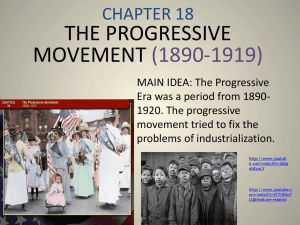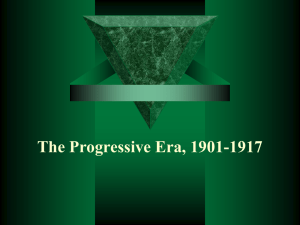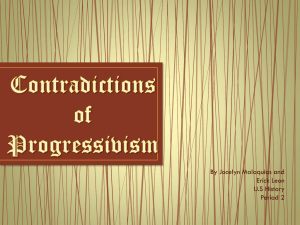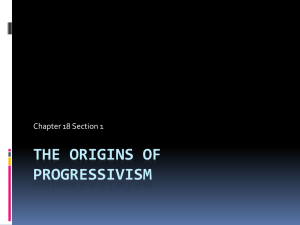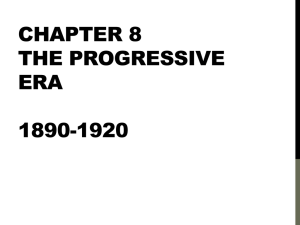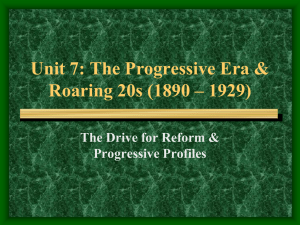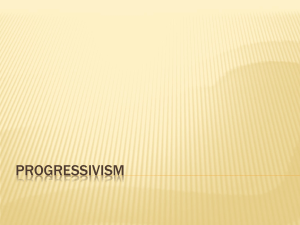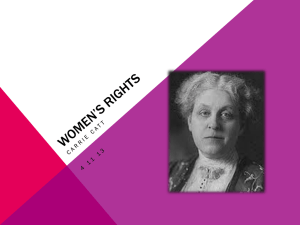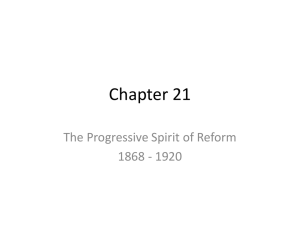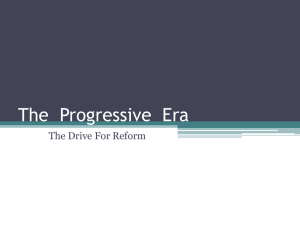The Progressive Movement 1890-1919
advertisement
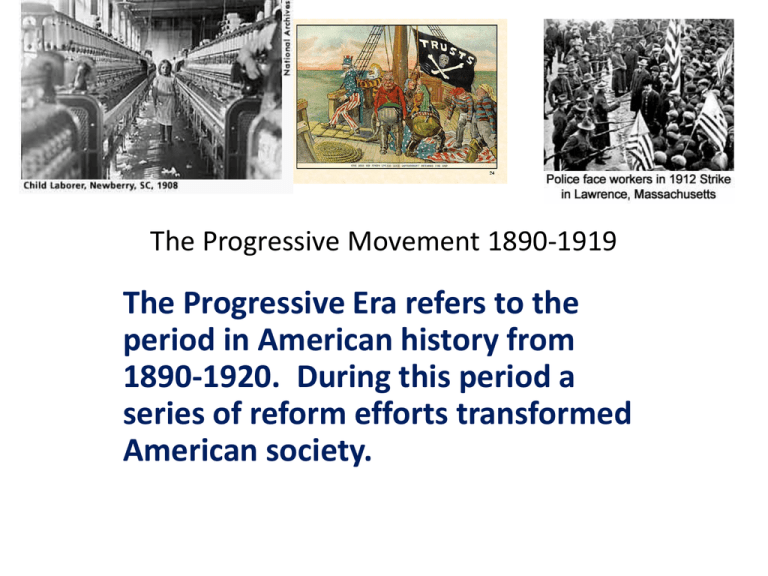
The Progressive Movement 1890-1919 The Progressive Era refers to the period in American history from 1890-1920. During this period a series of reform efforts transformed American society. Key Terms • Tenement: multi-family apartments, usually dark, crowded, and barely meeting minimal living standards • Skyscraper: a very tall building • Political machine: an organization linked to a political party that controlled local government • Graft: getting money in dishonest ways, such as bribing a politician • Urbanization – During the three decades after the Civil War, the urban population of the US grew from around 10 million in 1870 to over 30 million in 1900. • NY City grew from about 800,000 in 1860 to about 3.5 million in 1900. • Chicago grew from 109,000 in 1860 to 1.6 million by 1900. • The USA had 131 cities in 1840; by 1900, that number had risen to 1,700. Tenements • In growing US cities, wealthy people and the working class lived in different parts of town. • The wealthiest families lived in fashionable districts in the heart of the cities. • The middle class moved away from the city centers, living in “street car suburbs.” • The working class lived in dark, crowded multi-family apartments known as tenements Progressivism Era: What I need to know from today’s lecture? • When was the Progressive Era? • What is a “muckraker”? • Who were some famous “muckrakers”? Who were the Progressives? • Progressivism was not a tightly organized political movement. • Rather, it was a collection of different ideas and activities seeking to fix the problems they believed existed in American society. Progressives… • believed that industrialism and urbanization had created many social problems. • believed that government should take a more active role in solving society’s problems. • belonged to both major political parties. • were often urban, educated, middle-class Americans. How and why did the Progressive era come about? • Progressivism was partly a reaction against laissez-faire economics. • People increasingly came to distrust the unregulated market and economy of the 19th century. • Many came to believe that the economy on its own could not solve many of the social problems emerging by the end of the 19th century as a result of industrialization and urbanization. • Many began to see and believe that science and technological improvements of the period could also be used to create a better society. The Muckrakers • Muckrakers: – a group of journalists and writers who investigated and often exposed dangerous or unsanitary social conditions and political corruption. – Muckrakers brought to light corruption in different areas of American society. Sponge Activity In the late 19th century, immigration most affected American cities by contributing to which of the following? • • • • a. Overcrowded housing b. Movement to the suburbs c. Development of city parks d. Financing railroad construction Sponge Activity As a result of increased immigration to the United States in the late 1800s and early1900s, many immigrant families lived in tenements because — • a. there was a lack of affordable housing in overcrowded cities • b. adequate housing was scarce on the Great Plains • c. they wanted to avoid living in ethnic neighborhoods • d. the U.S. government provided them with free housing Muckrakers • Ida Tarbell • American teacher • muckraker • author and journalist • Wrote a series of highly critical articles about Standard Oil Company in McClure’s magazine. Jacob Riis • A social reformer and “muckraking” journalist and photographer • Used his talents to expose the poverty, disease, and crime that afflicted immigrant neighborhoods in New York City. • His influential book How the Other Half Lives, published in 1890, brought to light the horrific living conditions of the poor. • • Riis became known as the “Emancipator of the Slums” because of his work. Long ago, ... it was said that 'one half of the world does not know how the other half lives.' ... It did not know because it did not care ... until some flagrant outrage on decency and the health of the community aroused it to noisy but ephemeral indignation.” Lewis Hine Another free-lance photographer of the era. Hine focused on child labor, and believed that if people could only see the abuses of child labor, they would demand an end to such evils. Child-laborers/coal-miners Watch your Step! Upton Sinclair (1878-1968) • A famous muckraking journalist • Wrote the novel The Jungle. – exposed the foul conditions of the U.S. meat packing industry • The Jungle became an instant best-seller. – It told how dead rats were shoveled into sausage-grinding machines – how inspectors allowed diseased cows to be slaughtered for beef – and how cow “filth” and guts were swept off the meat-packing floors and packaged as “potted ham.” MEAT PROCESSING PLANT A Chicago meat processing plant in 1906 such as the kind Sinclair wrote about. WHAT’S IN YOUR HAMBURGER? “If I was a muck-raking journalist” • Write a brief paragraph on what social issue you would write about if you were a muckraking journalist. – About your, community, or your local, state, or national government. Progressive Era Reform • Evaluate the impact of Progressive Era reforms including [initiative, referendum, recall, and] the passage of the 16th and 17th amendments. (TEKS US 4A) • Evaluate the impact of reform leaders such as Susan B. Anthony, W.E.B. Dubois, (NAACP), [and Robert LaFollette] on American society (initiative, referendum, and recall). (TEKS US 4B) (TAKS 3) • Evaluate the impact of third parties and their candidates such as Eugene V. Debs (Socialist Party, Progressive Party, and Populist Party). (TEKS US 4C) • Trace the development of the conservation of natural resources, including the establishment of the National Park System and efforts of private nonprofit organizations. (John Muir, Gifford Pinchot, and Yosemite). (TEKS US 11B) Key Terms • Direct Primary: a vote held by all members of a political party to decide their candidate for public office • Initiative: the right of citizens to place a measure or issue before the voters or the legislature for approval • Referendum: the practice of letting voters accept or reject measures proposed by the legislature • Recall: the right that enables voters to remove unsatisfactory elected officials from office • Suffrage: the right to vote Progressive Era Reforms • What kind of reforms did progressives seek? • What is a “direct” election? • What is a “referendum”, an “initiative”, or a “recall”? • What was the 17th Amendment about? Democracy and Progressivism • Many progressives wanted to make government more democratic and more responsive to the voters. • They believed a more democratic government would be able to make the changes necessary to reform or improve society. • Many progressives worked for political reform on the state level. Democracy and Progressivism • Robert La Follette (1855-1925) • • governor of Wisconsin in 1901. He wanted citizens to have a more direct role in government. • La Follette championed progressive reforms, such as: – – – – – workers’ compensation railroad rate reform minimum wage corporate regulation an open “direct” primary system – He supported trade unions as a check on the power of large corporations. Democracy and Progressivism • • Robert M. La Follette attempted to run for president in 1912 La Follette pressured the state legislature to require each party to hold a direct primary – • an election where all party members can vote for a candidate to run in the general election. In the direct primary, party members who want to run for office file petitions to have their names placed on the ballot, allowing voters to vote directly for the candidates of their choice. Democracy and Progressivism • Two types of direct primaries exist. – A closed primary, used in almost all of the states, is limited to those people who have previously registered as members of a party in whose primary they are voting. – An open primary allows individuals to vote across party lines as in the regular election process. Democracy and Progressivism: Initiative, referendum, and recall • Inspired by La Follette, Progressives in other states pushed for similar electoral changes. Among these changes were the: • Initiative: allows a group of citizens to introduce legislation and requires the legislature to vote on it. • Referendum: allows proposed legislation to be submitted to the voters for approval. • Recall: allows voters to demand a special election to remove an elected official from office before his or her term has expired. Direct Election of Senators and the 17th Amendment • Another political reform the progressives favored concerned the federal government. Originally, the US Constitution directed each state legislature to elect two senators from each state. Political machines or large trusts often exercised great influence in these selections. • To counter the Senate corruption, progressives called for the direct election of senators by all state voters. In 1912, Congress passed a directelection amendment. • In 1913, the amendment was ratified, becoming the 17th Amendment to the Constitution. • Direct election is a term describing a system of choosing political officeholders in which the voters directly cast ballots for the person, persons or political party that they desire to see elected. Making Government More Efficient While many Progressives focused on issues relating to democracy , others focused on making government more “efficient.” Many of these progressives took their ideas from the business world—they believed business had become more “efficient” by applying the principals of “scientific management.” The ideas of scientific management had been developed in the late 1800s and were popularized by Frederick W. Taylor in his book The Principles of Scientific Management, publised in 1911. Commission Plan Efficiency progressives argued that managing a modern city required experts, not politicians. Saw the democratic process as leading to corruption and compromise. These progressives sought to place a city’s government under a commission plan. This meant that a city’s government would be divided into several department, each department placed under the control of an “expert” commissioner. MATCH THE TERM TO THE DEFINITION • William Mckinley _______ • JACOB RIIS: ______ • IDA TARBELL: ______ • Robert La Follette ______ • UPTON SINCLAIR: ______ • JOSEPH PULITZER: ______ • 17th Amendment ______ • Refendum ______ _______________________________ 1. A famous muckraker who wrote about Standard Oil Company 2. A writer and social reformer who wrote The Jungle 3. Wrote How the “Other Half Lives” 4. Newspaper publisher 5. A president assassinated in September, 1901 6. Progressive governor from the state of Wisconsin 7. allows proposed legislation to be submitted to the voters for approval. 8. Relates to the direct election of U.S Senators The Suffrage Movement • In July 1848, Elizabeth Cady Stanton and Lucretia Mott organized the first women’s rights convention in Seneca Falls, New York. • Their first priority: getting women the right to vote. • Suffrage is the right to vote. • Many progressives joined the movement in the late 1800’s and early 1900’s. The Suffrage Movement • After the Civil War, Republicans pushed for the 14th and 15th Amendments (1860’s and 1870’s) to protect the civil and voting rights of African Americans. • Many leaders of the woman suffrage movement want to give women the right to vote as well. The Suffrage Movement • The debate over the 14th and 15th Amendment split the suffrage movement into two groups. • One group, the National Woman Suffrage Association (Elizabeth Cody Stanton, Susan B. Anthony) wanted to focus on passing a constitutional amendment allowing woman the right to vote. • The second group, known as the American Woman Suffrage Association (Lucy Stone, Julia Ward Howe) believed it was best to push individual states to allow women the right to vote prior to trying to amend the Constitution. Susan B. Anthony & the Women’s Suffrage Movement • Susan B. Anthony (1820-1906) – Her parents were Quakers and supportive of women’s right – Received a good education – Fought for temperance and abolition of slavery before the Civil War – In 1869, she formed the National Woman Suffrage Association with Elizabeth Cady Stanton – She and her organization pushed for a constitutional amendment granting women the right to vote – Died in 1906 and did not live to see the results of her life-long struggle for women’s suffrage. – 19th Amendment (1920) grants women right to vote The Suffrage Movement • In 1890, the two groups united to form the National American Woman Suffrage Association. • As the suffrage movement grew, members began lobbying lawmakers, organizing marches, and delivering speeches on street corners. • By the end of 1912, Washington, Oregon, California, Arizona, and Kansas had granted women full voting rights. The Suffrage Movement • 19th Amendment: As more states granted women the right to vote, Congress began to favor a constitutional amendment allowing women the right to vote. • In 1918, the House of Representatives passed a woman suffrage amendment. • In 1920, the 19th Amendment guaranteeing women the right to vote went into effect. Temperance and Prohibition • Many progressives believed alcohol was responsible for many problems in American life. • Social workers decried the effects of alcohol consumption on families and the fact that scare wages were wasted on drinking. • Some employers believed drinking hurt worker productivity, and saw drinking saloons as places where machine politicians could thrive. • The temperance movement advocated the moderation or elimination of alcohol. Temperance and Prohibition • The Women’s Christian Temperance Union (WCTU) formed in 1874; by 1911 it had nearly 250,000 members. Another organization was the Anti-Saloon League. • At first the temperance movement sought to reduce alcohol consumption. • Later it pressed for Prohibition—laws banning the manufacture, sale and consumption of alcohol. Health and Safety • Triangle Shirtwaist Company fire in New York City: • http://www.cleanvideo search.com/media/acti on/yt/watch?videoId=g KdMuVu1wi8 Social Welfare Progressivism • • • • While many Progressives focused on reforming the political system, others focused on social problems, including: Crime, illiteracy, alcohol abuse, child labor, and health and safety. Campaign Against Child Labor: In 1900 over 1.7 million children under the age of 16 years old worked outside the home. Reformers established the National Child Labor Committee in 1904 to abolish child labor. John Spargo’s 1906 book called The Bitter Cry of the Children told how coal mine companies hired children as young as 9 or 10 years of age to work ten hour days for 60 cents daily. Social Welfare Progressivism • Many states began passing compulsory education laws during this period, partly as a result of these progressive efforts. The Limits of Progressivism • The Progressive movement in this period failed to address African American reform issues. • African Americans also sought to reform society, promote equality, and advance their civil liberties. • The Niagara Movement – In 1905, W.E.B. Du Bois and 28 African American leaders met at Niagara Falls to demand full political rights for African Americans. The Limits of Progressivism • In 1909, Du Bois and others formed the National Association for the Advancement of Colored People (NAACP). – Political Equality – An end to racial discrimination and lynching – the elimination of barriers preventing African American from voting Progressive Era Reforms Review Making Government more Efficient • Commission Plan – A city’s government would be divided into several departments. Each department placed under the control of an export commissioner More Democratic and Responsive Governments • Direct Primary • Political Reforms – Initiative – Referendum – Recall • 17th Amendment (1913) • Direct election of U.S. Senators More Democractic Government: Women’s Suffrage • Susan B. Anthony – 19th Amendment (1920) • guaranteed women the right to vote Social Welfare “Reform” • National Child Labor Committee formed in 1904 to abolish child labor • Muckraker John Spargo’s (1906 )book The Bitter Cry of the Children exposed the horrible labor conditions of child workers • States pass laws requiring minimum age for employment • States pass laws for Compulsory Education Social Welfare Reform • Health and Safety Codes – Workers’ Compensation laws – Building Codes – Sanitation • Meat Inspection Act (1906) – required federal inspection of meat sold through interstate commerce – Required the Agriculture Department to set standards of cleanliness in meatpacking plants • Pure Food and Drug Act (1906) – Prohibited the manufacture, sale, or shipment of impure or falsely labeled food and drugs Temperance and Prohibition • The temperance movement advocated the moderation or elimination of alcohol. • Women’s Christian Temperance Union (WCTU) – Worked to reduce alcohol consumption – Later pushed for prohibition: Laws banning the manufacture, sale and consumption of alcohol Conservation • Newlands Reclamation Act (1902): authorized the use of federal funds from public land sales to pay for irrigation and land development projects • Gifford Pinchot • appointed head of the US Forest Service • Created protected forests, national parks Regulating Big Business • Progressives fought the concentration of wealth into the hands of the few – Targeted trusts and large holding companies • giant corporations that dominated the industries – Some reformers advocated socialism: the idea that the government should own and operate industry for the community as a whole • Eugene Debs: ran for president in 1912 as the American Socialist Party candidate • Obtained nearly 1 million votes Regulating Big Business • Creation of the Federal Trade Commission (1914) – Agency created and given power to investigate and issue “cease and desist” orders against companies involved in unfair trade practices or unfair trading practices which derive a gain at the expense of the competition • Clayton Antitrust Act (1914) • The act banned tying agreements • Banned price discrimination • Declared unions were not “unlawful combinations” Regulating the Economy • Underwood Tariff (1913) • Reduced the average tariff on imported goods to about 30% of the value of the goods, or about half the tariff rate of the 1890s • Allowed for the levying of an income tax: a direct tax on the earnings of individuals and corporations • 16th Amendment (1913) • Made it legal for the federal government to tax the income of individuals directly
